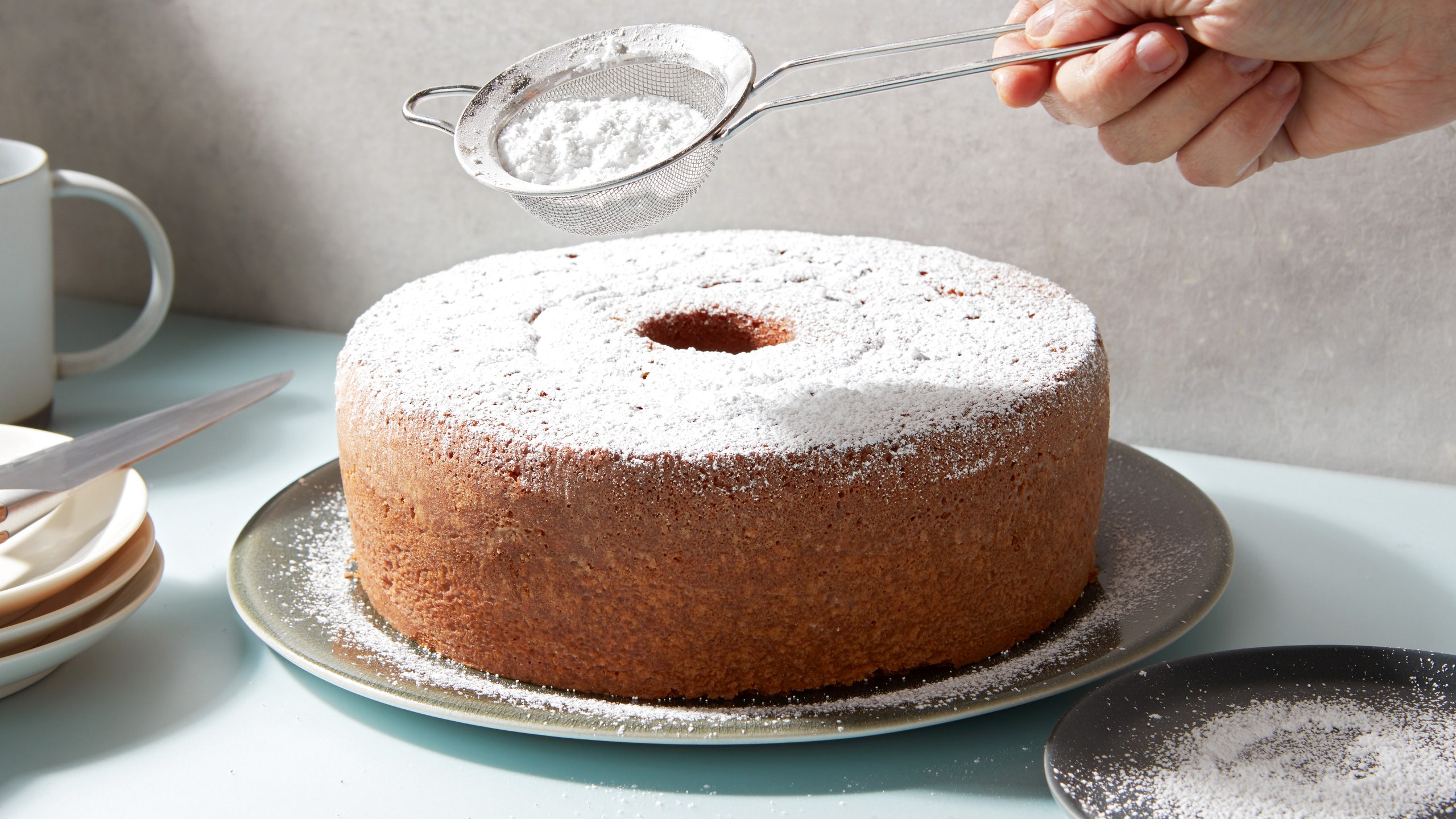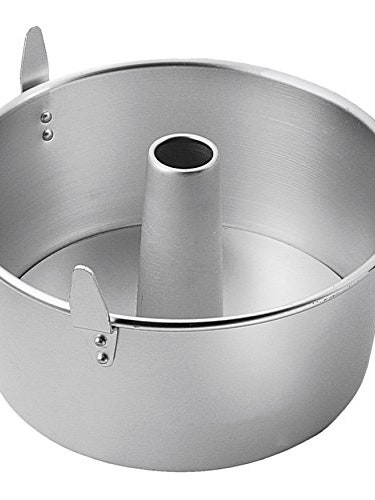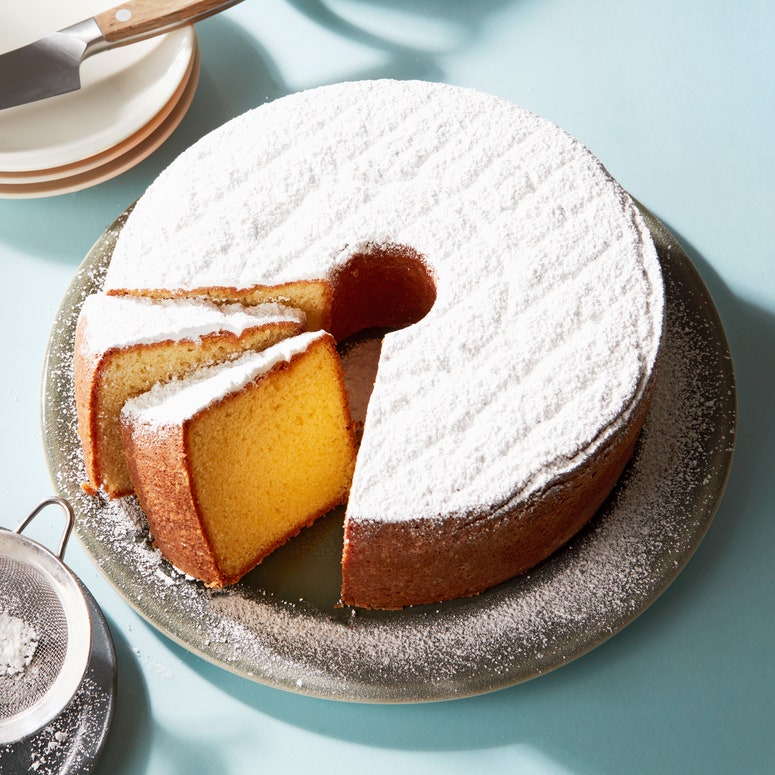All products featured on Epicurious are independently selected by our editors. However, when you buy something through our retail links, we may earn an affiliate commission.
In my family the obsession with Philly fluff cake is multigenerational. My grandmother, my mother, and I are all bound by our love for this cake, a specialty of our local bakery in New Jersey. And we are not alone: In our corner of suburbia, it has an avid fan base. Throughout my childhood, the sugar-dusted cake showed up at almost every party, a permanent fixture at housewarmings, block parties, and Rosh Hashanah celebrations.
What exactly makes this specialty cake so, well, special? The Philly fluff cake’s texture falls somewhere between angel food cake and pound cake—it’s both ethereally light and richly dense. Baked in a tube pan, the cake is served with the bottom facing up to provide maximum surface area for the thick layer of powdered sugar on top (touch it and your fingerprints will leave impressions, like boots in the snow). Even after years of working in professional kitchens, this is the cake I still fantasize about. But unless you’ve spent a significant amount of time in New York or New Jersey, you may have never even heard of it.
Though the name might suggest otherwise, Philly fluff cake has nothing to do with the city of Philadelphia. Named for the iconic dairy brand, the cream-cheese-enriched pound cake is a specialty of Long Island and New Jersey—an “if you know you know” offering at countless bakeries, specifically Jewish (and sometimes kosher) establishments.
Michael Weiss grew up on the Long Island’s South Shore, where “the Philly fluff is a phenomenon,” he says. Fielding requests from friends, Weiss drove the highly sought-after cakes from bakeries in Long Island to Westchester. He shipped Philly fluffs to his father in Florida, engendering his eventual business idea: a mail-order Philly fluff cake company. Weiss started Mike’s Philly Fluff with the goal of capturing the nostalgia of childhood trips to his local Long Island bakery.
When I told Weiss I’m from New Jersey, he immediately asked if the Philly fluff cake I grew up with was from Natale’s. “Yes,” I laughed, surprised its reputation had extended so far. Natale’s Bakery—a Summit, New Jersey, institution dating back to 1938—produces all the Jewish-Italian desserts of my childhood: The almond-tinged rainbow cookies, layered with two types of jam and a gloss of ganache; the tiny cannolis, filled with silky mascarpone and miniature chocolate chips—but it’s famous for its Philly fluffs. The cakes are kept behind the counter, stacked in pale green boxes. You have to know to ask for one. All the locals know, and for many of us, the cake is the subject of a cult-like obsession.
Look at Natale’s Tripadvisor page and you’ll find countless love letters to the cake: “There are many, many reasons to love Natale's, but for me it's their Philly Fluff,” writes Kristin L. “It’s my go-to dessert when company is coming.” Plenty tote the cake across state lines to share with family or friends: “I live in Connecticut and would definitely make the drive for this cake,” writes Barbara T., who received the cake as a Christmas gift. Rhode Island-based Jenifer D. also received the cake as a gift; she’d never heard of the Philly fluff before and assumed it was “just a tube poundcake,” then promptly corrected herself: “WRONG. This cake is delicious…One of the yummiest cakes I have ever tasted.”
Understandably, Natale’s keeps the recipe for its Philly fluff cake under lock and key—it’s the bakery’s best-seller. But that hasn’t stopped plenty of locals from attempting to recreate it. Ever since my grandmother first tasted this cake, she’s been on a mission to reverse-engineer it. A few months ago, she recruited me (a former professional baker) to join her on the mission.
Some food magazines and blogs have published recipes for Philly fluff cake, but none of them looked like my plush vanilla muse from Natale’s. The versions from Serious Eats and Food & Wine both included a zebra-esque stripe of chocolate running through the cake which, as I’ve since learned, was how the cake was originally presented.
The Philly fluff cake was first invented by Harry Zipes at once-famed Bruce’s Bakery in Great Neck, Long Island. “My father Harry was constantly trying to make every item in his bakery just a little bit better,” writes Bruce Zipes in Bruce’s Bakery Cookbook, where he published his father’s recipe for Philly fluff cake. “In this case, he took a basic pound cake and added extra cream cheese and lots of real butter. The result was a moist, dense, super-rich cake, which has become our signature.”
Zipes swirled the batter with chocolate and baked the cake in a Bundt pan. Philly fluff cake quickly became the bakery’s best-seller.
You’ll find cream-cheese enriched pound cakes across the country—they’re particularly popular in the Southern US. But what makes this one unique? I found the answer in a vintage copy of Bruce’s Bakery Cookbook. Most cream cheese pound cakes contain just two types of fat: cream cheese and butter. In his original recipe, Zipes upped the ante with three types of fat: cream cheese, butter, and shortening. While some spinoff recipes forgo one of these elements, trading the shortening for oil or skipping it altogether, I found in my testing that using the full trifecta is the key to Philly fluff cake’s miraculous light-but-dense texture.
Like Zipes’s original, my Philly fluff cake recipe contains three types of fat: cream cheese, butter, and shortening. The cream cheese contributes lactic tang; the butter adds richness; and the shortening keeps the cake light as a cloud. (The shortening in the batter also keeps the cake fresh for days—in fact, it’s one of those rare cakes that only improves with time.) Instead of the standard procedure of creaming the butter and sugar, my recipe relies on reverse-creaming. I found that coating the flour with the fat gives the cake its tight, tender, supple crumb.
Once I finalized the recipe, I baked my version of the Philly fluff cake for my grandmother and mother. “I think you hit the nail on the head,” Grandma texted me (yes, Grandma texts!); my mom sent a heart-eye emoji. Both of them immediately requested the recipe, and now we can all bake our favorite cake in the world.


